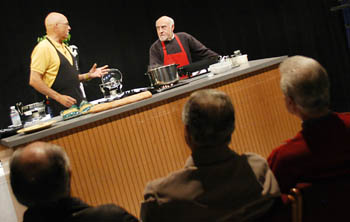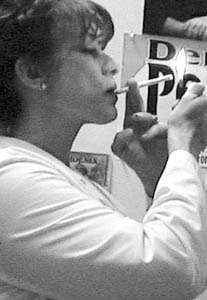![[Metroactive News&Issues]](/gifs/news468.gif)
[ Silicon Valley | Metroactive Home | Archives ]
|
5,000--estimated number of public, educational and governmental (PEG) TV channels in America $100 million--amount Comcast spent last year to broadcast 2,400 PEG channels 6--minimum number of PEG channels Comcast has cut services to in the past two years $25 billion--amount of debt Comcast assumed when it acquired AT&T Broadband in 2002 |

Home Baked: Producers of community-access shows, like the chefs of 'Who's Cookin,' face steep prices for studio time. Wayne's World, the Next Generation Community-access television in San Jose will soon undergo major changes. Will that be enough to put it on a par with award-winning channels in Mountain View and Palo Alto? By William Dean Hinton Like many people on television, Bill Chew is a much different personality on-camera than he is in person. Away from the glare of the studio lights, Chew is eccentric, offbeat. He is best known as the guy who roller-skates around San Jose dressed all in white, even to the top of his head, where a straw cowboy hat usually rests. Chew is so adept at skating that he rolls into San Jose City Council meetings, filming councilmembers with a hand-held camcorder. He likes to capture officials in unguarded moments, like Forrest Williams of District 2 taking the occasional nap, which Chew prints on paper, distributing to those who might find Williams' narcoleptic tendencies amusing. Chew has run for mayor four times, so he's learned the gift of the gab. He talks so much a Metro reporter pronounced him a peripatetic windbag several years back. In front of the camera, Chew, who turns 54 next month, tones things way down. His body becomes stiff, his hands resting in his lap. He rarely, if ever, gestures. His gaze locks on his subject, his eyes glancing to his left only when a studio tech gives him the 10-, five- and one-minute countdowns. Tennis shoes matched with a red-white-and-blue tie are the only signs of Chew's comic sensibilities. Last Friday afternoon, Chew completed more than a decade of broadcasting NeighborNet, his political talk show, which airs Monday nights at 8pm on San Jose's community-access Channel 15. By his own admission, Chew might not last another 10 months. Comcast, the largest cable provider in America with $56 billion in revenues last year, raised the rates Jan. 1 for shows like Chew's produced in Comcast's 10th Street studio. The old rate was $45 for half an hour. The new rate is $65, a 46 percent increase. Comcast vice president Andrew Johnson considers the raise a necessary operating expense. "We haven't increased our rates in seven years, since 1996, which averages about $3 a year," Johnson says. "The increase represents the rising cost of electricity. It's the amount of lights going up by $3 a year." But given Comcast's short history with community-access programming in San Jose, the rate hike looks like another attempt to force producers off the air. "It's turning into rich-guy access shows," says Chew, a retired product developer. Last summer, Comcast filed an injunction against San Jose, in part because city officials were asking the city's next cable provider for $39 million to improve the infrastructure of educational, governmental and community-access television. The improvements were part of the city's cable franchise renewal agreement, which will net the next cable operator, probably Comcast, $1.5 billion over the life of the contract. Among other things, city officials asked for an I-Net linking more than 300 civic buildings with fiber-optic capabilities (25 times faster than DSL lines), interactive and broadband services throughout the city and additional, digitized community-access channels. Comcast tried an unusual approach to convince federal magistrate Richard Seeborg to grant the injunction. The conglomerate, which supplies a third of the nation's homes with cable television, argued that San Jose officials were trampling Comcast's First Amendment rights. Not only was the infrastructure costly, it also curtailed the types of programs Comcast could broadcast to the public. In effect, Comcast was hoping to subtly convince its cable audience that community-access television was intruding on programming. The public would then eventually agree that small-time producers like Chew were better suited to the Internet, leaving the cable spectrum available to more sports and reruns of sitcoms. "What Comcast has done is turn cable television into a popularity contest," says Gary Larson, an analyst for the Center for Digital Democracy, which advocates for increased public interest programming. "Community access is expensive. There's not a huge public outcry for it. No one wants to watch it. Comcast is hoping the public says, 'What the hell, I don't want to see another boring Spanish professor.' Public access is a niche market. Comcast knows that. If it were left up to the people, they'd vote this stuff down. That's a tragedy." It's a tragedy because community-access television is not television in the traditional sense. It's more like a public resource similar to a library. Religious, political and cooking shows are the staple of community-access programming. But you can also find shows about atheism, poetry, rap music, yoga, animal adoption and health care. Some programs are filmed in Spanish, Samoan, Croatian, Farsi and Tongan, reflecting issues important to those groups. Many people appreciate the airtime because it provides unfiltered access to San Jose's 159,000 cable subscribers. Former Assemblywoman Elaine Alquist, a candidate for state Senate District 13 who appeared on NeighborNet for the fifth time Monday, says she seeks out nontraditional media because reporters often display bias toward the story they'd like to write rather than the story she hopes to tell. "Journalists keep asking you questions until you give the answer they want," she says. On one hand, community-access television is an anthropological experience, allowing viewers to learn about other cultures as if they were watching the Discovery Channel. On the other hand, community access can be considered cable television's local channel, as if we literally turned the cameras on ourselves to see who we are without Hollywood makeovers. "You don't see a lot of middle-aged women with pot bellies on television--people like me," says Bunnie Reidel, executive director of Alliance for Community Media. "Community access is a reflection of who we are."
In Waiting In September, federal magistrate Seeborg dismissed Comcast's claim for an injunction, saying San Jose's infrastructure requests were content neutral and narrowly tailored to achieve the city's aim for better civic broadcasting. Comcast lost round 1 but still has a lawsuit pending, so nothing has been decided. After resolution of the suit, which is based on the same arguments as the injunction, the city and cable operator still must work out an agreement before anyone knows what happens next with community-access television. But the city has already moved beyond Comcast by forming a nonprofit organization, headed by Gerry DeYoung, president of a local planning firm, which will take over the operation of the community-access studio with money obtained from Comcast. The San Jose Community Media Access Corp. has 14 board members, no budget, and hasn't met in more than a year. "It's kind of like a nonprofit in waiting," says city spokesman Tom Manheim. Before the board was formed, city officials became aware that San Jose's community access studio had been "understaffed, underfunded and underpromoted," says Ross Braver, San Jose's video communications manager. Unlike stations in Palo Alto and Mountain View, San Jose community access has no website where residents can learn how to register for classes and locate show schedules. Nor does the San Jose station roll over programming 24 hours a day, so shows repeat throughout the week. Comcast employs professional, competent technicians, but the company laid off several workers affiliated with community access last fall. Worst of all: San Jose has a two-year wait for those who want to produce their own shows. Palo Alto and Mountain View have no list. Residents can produce programs in a matter of months. Palo Alto, which broadcasts over two community-access channels to 25,000 subscribers, and Mountain View, which broadcasts to 38,000 homes (in Los Gatos, Cupertino as well as Mountain View) also over two channels, have won a number of awards from the Alliance for Community Media. The awards are not given for the quality of programming but for the accessibility of studios and equipment. "We're more concerned with how many people they train," says Reidel, the Alliance director. "How many people use the channel? What kinds of outreach do they do? How do they market themselves?" People interested in producing their own shows can sign up for a class for about $65. Studio time is $20 for an hour-and-a-half session--the same hour and a half for which Chew pays nearly $200. Palo Alto and Mountain View, which both moved into new, modern facilities in the last year, have operated under the nonprofit model since their inception--Palo Alto since 1990, Mountain View since 1983. Producers recruit from a list of volunteers who operate camera equipment and work the video board. Camcorders are available for checkout for $20 per day. Anything is broadcast as long as it is not obscene or libelous. "People always want to tell me why their show is great," says Annie Niehaus, executive director of Palo Alto's Media Center. But Niehaus wields no veto power over a show's content. The idea is to create a generation of amateur storytellers willing to explore the unmined terrain ignored by mainstream media. "We used to be a high-touch, low-tech society," says Douglas Broomfield, executive director of Mountain View's KMTV-15. "Now we're a high-tech, low-touch society. People are not out in their neighborhoods as much." Perhaps some day community access will be considered a hip public resource similar to the Internet. Already it's making inroads. Suzie Andrews is a former bodybuilder who is part of the ongoing medical marijuana movement. In the mid-1990s, during the public debate over whether Andrews could add a marijuana clinic to her West San Carlos Street head shop, a supporter told her she should educate the public by producing a show on the community-access channel. After sitting on a waiting list for two years, Andrews debuted the Silicon Valley Medical Marijuana Update by traveling to the dismantling of the San Francisco cannabis club run by Dennis Peron, originator of the legislation decriminalizing marijuana for medical purposes, where Andrews smoked a joint for the camera. A hundred joints later, Andrews is still going strong, educating her audience on how to harvest plants, cut up bud, smoke from bongs and bake pot cookies. She makes road trips into what she calls the field of dreams, thousands of cannabis plants taller than a human being. Pot patients write to tell her she's a genius. Young guys try to hit on her. "College kids love me," she says. "They all know about my show." Mess with that, Comcast, and there will indeed be hell to pay.
Send a letter to the editor about this story to letters@metronews.com. [ Silicon Valley | Metroactive Home | Archives ]
|
From the January 29-February 4, 2004 issue of Metro, Silicon Valley's Weekly Newspaper.
Copyright © Metro Publishing Inc. Metroactive is affiliated with the Boulevards Network.
For more information about the San Jose/Silicon Valley area, visit sanjose.com.
